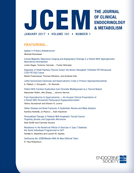-
Views
-
Cite
Cite
BARBARA M. LIPPE, ELLIOT M. LANDAW, SOLOMON A. KAPLAN, Hyperthyroidism in Children Treated with Long Term Medical Therapy: Twenty-Five Percent Remission Every Two Years, The Journal of Clinical Endocrinology & Metabolism, Volume 64, Issue 6, 1 June 1987, Pages 1241–1245, https://doi.org/10.1210/jcem-64-6-1241
Close - Share Icon Share
We use an antithyroid drug for the treatment of hyperthyroidism due to Graves’ disease in children and adolescents for as long as the patients are willing to comply and<or tolerate the drug. In more than 60 patients treated since 1961, the remission rate was 25% in the first 2 yr. This report looks at these same patients again, followed for an additional 5 yr. Survival analysis methods applied to the follow-up data on 63 children confirm our original statistical findings and suggest a continuing remission rate of 25% every 2.1 ± 0.4 (±se) yr regardless of the duration of previous therapy. The median time to remission was 4.3 ± 1.5 yr, and 75% of patients are predicted to be in remission in 10.9 ± 2.3 yr. Of 36 patients who went into remission, defined by their being euthyroid for 1 yr after cessation cessation of therapy, 1 relapsed, and 2 developed spontaneous hypothyroidism; the remainder are euthyroid 1–11.7 yr after therapy was discontinued. Of 14 who switched from medical therapy, 2 of 7 treated surgically and 4 of 7 treated with 131I are hypothyroid. Only 1 patient had a significant adverse reaction to both methimazole and propylthiouracil. While medical therapy may have some direct effect on the autoimmune response in hyperthyroidism, its role in affecting the time to ultimate remission is unknown. These data, however, describe the course of children so treated and allow us to present therapeutic options initially or during treatment based on statistically derived probabilities of outcome.





